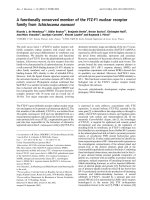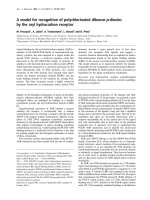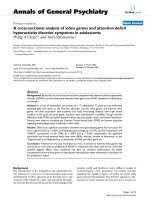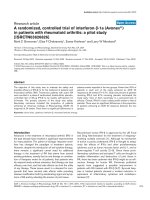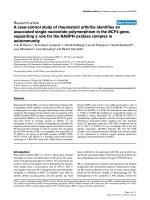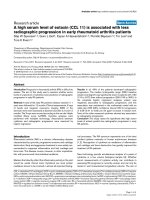Báo cáo y học: " A retrospective quality assessment of pre-hospital emergency medical documentation in motor vehicle accidents in south-eastern Norway"
Bạn đang xem bản rút gọn của tài liệu. Xem và tải ngay bản đầy đủ của tài liệu tại đây (294.46 KB, 11 trang )
ORIGINAL RESEARCH Open Access
A retrospective quality assessment of pre-hospital
emergency medical documentation in motor
vehicle accidents in south-eastern Norway
Trine Staff
1,2,4*
and Signe Søvik
3
Abstract
Background: Few studies have evaluated pre-hospital documentation quality. We retrospectively assessed
emergency medical service (EMS) documentation of key logistic, physiologic, and mechanistic variables in motor
vehicle accidents (MVAs).
Methods: Records from police, Emergency Medical Communication Centers (EMCC), ground and air ambulances
were retrospectively collected for 189 MVAs involving 392 patients. Documentation of Glasgow Coma Scale (GCS),
respiratory rate (RR), and systolic blood pressure (SBP) was classified as exact values, RTS categories, clinical
descriptions enabling post-hoc inference of RTS categories, or missing. The distribution of values of exact versus
inferred RTS categories were compared (Chi-square test for trend).
Results: 25% of ground and 11% of air ambulance records were unretrieveable. Patient name, birth date, and
transport destination was documented in >96% of ambulance records and 81% of EMCC reports. Only 54% of
patient encounter times were transmitted to the EMCC, but 77% were documented in ground and 96% in air
ambulance records. Ground ambulance records documented exact values of GCS in 48% and SBP in 53% of cases,
exact RR in 10%, and RR RTS categories in 54%. Clinical descriptions made post-hoc inference of RTS categories
possible in another 49% of cases for GCS, 26% for RR, and 20% for SBP. Air ambulance records documented exact
values of GCS in 89% and SBP in 84% of cases, exact RR in 7% and RR RTS categories in 80%. Overall, for lower RTS
categories of GCS, RR and SBP the proportion of actual documented values to inferred values increased (All: p <
0.001). Also, documentation of repeated assessment was more frequent for low RTS categories of GCS, RR, and SBP
(All: p < 0.001). Mechanism of injury was documented in 80% of cases by ground and 92% of cases by air
ambulance.
Conclusion: EMS documentation of logistic and mechanistic variables was adequate. Patient physiology was
frequently documented only as descriptive text. Our finding indicates a need for improved procedures, training,
and tools for EMS documentation. Documentation is in itself a quality criterion for appropriate care and is crucial
to trauma research.
1. Background
In trauma research, there are few studies of documenta-
tion quality in the pre-hospital emergency medical ser-
vices (EMS) that deliver care during “the golden hour”.
Important information on the mechanism of injury and
initial patient physiology can only be gathered at the
trauma scene, where several emergency services with
differing objectives interact. Trauma from motor vehicle
accidents (MVAs) is common, and these accidents place
a great burden on society, both personal and econom-
ical. In Norway, which has a population of 4.9 million,
the number of registered deaths from MVA in the study
year (2005) was 224 [1].
The World Health Organization has stated that there
is a need for studies on decisive factors in trauma out-
comes, for prevention, education, and health planning
purposes [2,3]. In Scandinavia, great efforts have been
made in recent years to improve early trauma care.
* Correspondence:
1
Department of Research, Norwegian Air Ambulance Foundation, Drøbak,
Norway
Full list of author information is available at the end of the article
Staff and Søvik Scandinavian Journal of Trauma, Resuscitation and Emergency Medicine 2011, 19:20
/>© 2011 Staff and Søvik; licensee BioMed Central Ltd. This is an Open Access article distributed under the terms of the Creative
Commons Attribution License ( which permits unrestricted use, distribution, and
reproduction in any medium, provided the original work is properly cited.
Guidelines have been developed for pre-hospital airway
management [4], for massive bleeding in trauma patients
[5], and for uniform reporting of data on major trauma
[6]. Still, an ongoing debate over the required skills
levels, procedures, methodology, and variables to be
reported by EMS delay the implementation of uniform
agreements [7-10].
This study was part of a cross-sectional MVA study
evaluating whether patient injury pattern and severity is
associated with e.g. accident type, mechanical distortion
of the vehicle, unrestrained objects in the vehicle, and
seat-belt use. Here, we hypothesized that the variation
in documentation tools, personnel training and patient
selection between EMS services would affect the quality
of pre-hospital documentation. Our retrospective study
sought to assess the completeness and quality of EMS
documentation of key logistic, physiologic, and mechan-
istic variables in MVAs from a trauma research perspec-
tive. To evaluate the documentation of patient
consciousness, respiration and circulation we chose to
assess the documentation rate of Glasgow Coma Scale
(GCS), respiratory rate (RR) and systolic blood pressure
(SBP), which are used to calculate the Revised Trauma
Scale (RTS). When neither exact values nor RTS cate-
gories were documented, we evaluated whether some
clinical descriptions or check box categorizations in
EMS reports could be used to post-hoc infer RTS cate-
gories for GCS, RR and SBP. Inference of categorical
values introduces uncertainties in research data but
greatly reduces data loss due to missing values.
EMS documentation is often performed in chaotic and
complex settings: in the dark, rain, and cold, under time
pressure, and sometimes under threat to personal safety.
Still, all research on pre-hospital trauma care, the use of
EMS, and mechanism of injury (MOI) in MVAs depends
heavily on this documentation. A potential consequence
of our study could be to increase the EMS services’ atten-
tion to documentation quality and to highlight the bene-
fit of a uniform, exact EMS reporting standard from the
perspective of using such data for trauma research.
2. Methods
This was a retrospective, observational, cross-sectional
study of the completeness and quality of EMS documen-
tation in MVAs. Completeness was studied by assessing
documentation rate. Quality of physiologic data was stu-
died by assessing whether variables were reported as
exact figures, as RTS categories, or through broadly
defined categories or free text precise enough to allow
post-hoc inference of RTS categories.
2.1. Setting
Data were collected from Dec. 1, 2004 to Jan. 31, 2006
from MVAs in nine counties in south-eastern Norway,
covering 136,000 square kilometres with a population of
2.7 million people. Seven Emergency Medical Commu-
nication Centres (EMCCs), 13 police districts, 99 ground
ambulance stations, five air ambulance bases, and one
Air Force search and rescue helicopter were active in
the study area. The ground and air ambulance systems
were both part of the specialised health service. The
ground ambulances were staffed with emergency medi-
cal technicians (EMTs) and/or paramedics. The air
ambulances were staffed with a pilot, an anaesthesiolo-
gist, and a rescue professional.
2.2. Data collection
Study approval and appropriate permits were obtained
from the Regional Committees for Medical and Health
Research Ethics, the Norwegian Directorate of Health
and Social Affairs, the Norwegian Data Inspectorate,
and the Attorney General. For all cases, we attempted to
retrospectively collect and review police reports, EMCC
reports, and ground and air ambulance records com-
pleted by EMTs, paramedics, or anaesthesiologists. Arri-
val records from hospitals or Local Emergency Medical
Centre (LEMC) were collected in cases where EMS
records could not be retrieved, because hospital arrival
records often cite information from the oral report rou-
tinelygivenbyEMSpersonnelwhenhandingovera
patient (Table 1).
Data were requested from those responsible for
administering the archives in the various services. Let-
ters of request to the different institutions were sent up
to three times in cases of no response. When ambulance
records could not be retrieved from the EMS, we
searched the in-hospital electronic patient record for
scanned-in copies. When a large number of ambulance
records were missing from any one EMS service, an
additional search in the hospital paper archives was
performed.
2.3. Eligibility criteria
Based on the dispatch criterion “motor vehicle accident
- suspicion of serious injury or death,” the EMCC noti-
fied one of the six research assistants engaged in our
project (experienced paramedics). The research assis-
tants were equipped with a uniformed motor vehicle
that had permission to function like an emergency vehi-
cle with light-and-siren response for the study purpose
only.
This study of documentation quality was part of a
cross-sectional MVA study evaluating whether patient
injury pattern and severity was associated with e.g. acci-
dent type, mechanical distortion of the vehicle, unrest-
rained objects in the vehicle, and seatbelt use. An MVA
was included in the study only if one or more patients
were transported by the EMS to a hospital or a LEMC
Staff and Søvik Scandinavian Journal of Trauma, Resuscitation and Emergency Medicine 2011, 19:20
/>Page 2 of 11
and the research assistant was able to collect mechanical
data from the motor vehicle. Collection of mechanical
data was performed in collaboration with the police and
the Norwegian Public Road Accident groups and was
both elaborate and labour demanding. Therefore, the
number of MVAs included in this study did not reflect
the true number of MVAs occurring in the study area.
2.2. Data sources and measurements
For each accident there was one police report. In acci-
dents occurring on the border between different EMCC
regions, up to three EMCC records could exist per acci-
dent. These were handled as one record for each patient
during data analysis. Each MVA could involve several
patients, and since each patient could be cared for by
Table 1 Data collection instrument
Accident number Motor vehicle number: Patient number:
Dispatch criterion Member from research accident team alerted and dispatched by the
EMCC
YN
Motor vehicle accident
- suspicion of serious injury or death
Patient record retrieved Police Y N
EMCC Y N
Ground ambulance Y N
Air ambulance Y N
In case of missing EMS records Hospital/LEMC Y N
Personal identification data Patient First name Y N
Patient Family name Y N
Birth date (6-digit) Y N
Social security number (11-digit) Y N
Logistic variables EMCC Unique Identifier Number Y N
Accident date Y N
Transport destination Y N Wrong
Patient encounter times
Alarm at EMCC Y N
Ground/Air ambulance departure from station Y N
Ground/Air ambulance arrival on scene Y N
Ground/Air ambulance departure from scene Y N
Ground/Air ambulance arrival at destination Y N
Glasgow coma scale (GCS) GCS exact value documented Y N
GCS RTS category 43210
GCS RTS category inferred Y N
GCS assessments repeated every 20 min Y N
Respiratory rate (RR) RR exact value documented Y N
RR RTS category 43210
RR RTS category inferred Y N
RR assessments repeated every 20 min Y N
Systolic blood pressure (SBP) SBP exact value documented Y N
SBP RTS category 43210
SBP RTS category inferred Y N
SBP assessments repeated every 20 min Y N
Variables relevant for mechanism of injury
(MOI)
≥ 2 MOI factors documented Y N
MOI reported as Check boxes Free
text
Patient location in vehicle Driver
Front
passenger
Rear passenger
Y N indicates whether variables were documented or not (Y = yes, N = no), for each relevant service.
Staff and Søvik Scandinavian Journal of Trauma, Resuscitation and Emergency Medicine 2011, 19:20
/>Page 3 of 11
more than one ambulance (ground and air), the sum of
ambulance records could exceed the total number of
patients.
Identification of involved patients was primarily per-
formed through police and EMCC reports. Associated
ground and air ambulance records were identified on
the basis of the EMCC record’s Unique Identifier, acci-
dent date, ambulance vehicle number, and the ID of
pre-hospital personnel. Hospital arrival records were
collected on the basis of patient ID. Incomplete police,
EMCC, and EMS documentation could therefore lead to
non-inclusion of patients. The total number of patients
thus reflects all patients ultimately identified by name
and social security number, which includes birth date.
Ambulance records were mainly filled in prospectively
and completed by the time the patient was handed over
to the receiving hospital or LEMC. In contrast, police
reports were completed retrospectively over a period of
days, on the basis of investigations and witness
interviews.
While there is no standard Norwegian ambulance
record, six of the nine counties used the same EMS
standard operating procedures, the Medical Operative
Manual (MOM). The study variables selected (Table 1)
were based on core data listed in the Norwegian
national health legislation, the MOM, the Norwegian
Index of Emergency Medical Assistance used by all
EMCCs, and the Utstein Guidelines for Major Trauma
[6,11-14]. These state that ambulance records should
document the date of the accident, full patient identifi-
cation, patient encounter times, physiologic measure-
ments, and relevant background information for each
patient, such as the mechanism of injury in the MVA.
Identification data gathered included patient first
name, family name, birth date, social security number
(which includes birth date), and the EMCC-generated
Unique Identifier number for each accident. Police,
EMCC and ground ambulance report eleven- digit social
security number, while air ambulance report birth date
only. All EMS services transporting patients from the
same accident mark their records with this EMCC
Unique Identifier.
Pre-hospital patient encounter times are not docu-
mented by the police, but the EMCC automatically
records the time points when the alarm call is received
and when an ambulance is dispatched. These time
points normally are electronically transmitted to the
ground and air ambulance services, which typically
directly transmit back into the EMCC record the times
of (1) departure from the station, (2) arrival on-scene,
(3) departure from the scene, and (4) arrival at the hos-
pital or LEMC. In addition, there are fields for manually
recording the same time data in the ambulance records.
We registered the frequencies of completion of these
patient encounter times, both in the electronic EMCC
records and in the ambulance records. Patient care time
was defined as the time interval from EMS arrival on-
scene to arrival at the hospital/LEMC. Documentation
of transport destination was registered as present, miss-
ing, or wrong (Table 1).
Core physiologic data include documentation of
patient consciousness, respiration, and circulation. The
MOM for the ground ambulances in the study area
does not specify a required level of detail or time resolu-
tion for the documentation of physiologic variables.
Glasgow Coma Scale (GCS) score, respiratory rate
(RR), and systolic blood pressure (SBP) are considered
key physiologic variables and are used to calculate the
Revised Trauma Score (RTS) [6,14-16]. As our criterion
for whether the physiologic EMS documentation would
be useful for trauma research we therefore registered
whether GCS, RR and SBP was documented in the EMS
records as (1) exact values or as (2) RTS categories (0-4)
(See Table 2) [15,16]. If no such GCS, RR, or SBP docu-
mentation existed, we evaluated whether clinical
descriptions of patient consciousness, respiration, and
circulation in check boxes or free text fields were suffi-
cient to reasonably post-hoc infer an RTS category.
Table 2 illustrates how clinical descriptions in ground
and air ambulance records were used to post-hoc infer
an RTS category value. When patient descriptions were
too ambiguous to reasonably infer a RTS category, data
were categorised as missing. The classification was per-
formed by one of the authors (TS) on the basis of pub-
lished clinical categories [6,14-16].
We also registered whether GCS, RR, and SBP assess-
ments, or clinical descriptions of consciousness, respira-
tion, and circulation, were repeated at least every 20
th
minute during patient care time. When patient care
time lasted less than 20 minutes, one documented
assessment of consciousness, respiration, and circulation
datawasconsideredsufficienttobeloggedas
“Repeated”. For records with missing patient encounter
times or missing GCS, RR or SBP data, the data fields
for repeated physiologic assessments were coded as
missing.
Mechanism of injury: For legal purposes, the police
attempts to identify the driver of each vehicle involved
in an MVA. The location in the car of the other injured
persons is only recorded as front or rear seat occupants.
In contrast, EMS services attempt to record the
mechanism of injury for all patients. According to local
procedures and international Utstein Guidelines, key
variables important in determining mechanism of injury
(MOI) in MVA patients include high vehicle speed,
patient location in the vehicle, cabin intrusion, ejection
from vehicle, death in the same compartment, entrap-
ment, impact direction, and vehicle roll-over. We
Staff and Søvik Scandinavian Journal of Trauma, Resuscitation and Emergency Medicine 2011, 19:20
/>Page 4 of 11
registered whether ambulance records documented two
or more of the factors describing MOI of the accident.
2.3. Data analysis
Data from ground and air ambulance records were com-
pared with the information available from police and
EMCC reports. Descriptive statistics and chi-square
tests for two-way analyses were performed in SPSS for
Windows v.18. Box plots illustrate the 25
th
-75
th
percen-
tile (box), bars represent the 90
th
percentile.
We hypothesised that documentation quality might be
better on ambulance missions with more severely
injured patients. Also, both mission profiles and person-
nel training was heavily skewed in our material. The
paramedic-staffed ground ambulances transport a broad
selection of patients, while the anaesthesiologist-staffed
air ambulance is dispatched when information in the
alarm call or from personnel already on-scene indicates
that patients are likely to be severely injured. We there-
fore used a chi-square test for trend [17] to compare
the distribution of RTS categories for GCS, RR and SBP
(five-level ordinal categorical variables) between patients
with documented exact values or RTS categories and
patients where RTS categories were inferred post-hoc.
By the same method, we evaluated whether poorer RTS
category was associated with improved time resolution
of physiologic measures (higher frequency of repeated
assessments).
3. Results
3.1. Demographic data
We included 190 accidents involving 338 motor vehicles
and 618 persons. Of these, 226 persons were excluded
because they were dead on-scene (n = 62), not injured
(n = 160), or transported by means other than EMS
(n = 4). Documented patient destination was a hospital
in 362 cases and an LEMC in 30 cases.
For the 392 patients included in the study, the number
of successfully retrieved records is listed in Table 3.
EMS records could not be retrieved for 25% of patients
transported by ground and 11% of patients transported
by air ambulance. For these 86 patients, we recovered
76 hospital arrival records.
All police reports were constructed using the same
template. All EMCC and air ambulance services also
used national, standardised records. In contrast, seven
different ground ambulance record templates were in
use in the nine counties. Three counties used the same
template, while in one county, two different templates
were used. Six of seven record templates were single-
paged, whereas one was two-paged.
3.2. Patient ID
Patient identification data varied between services.
Patients were identified by first and family name in 97%
of police, ground and air ambulance records, and in
81% of EMCC records. Eleven-digit social security num-
ber (including birth date) was documented in 380 of
392 (97%) police records, 300 of 401 (74%) EMCC
records, 138 of 231 (60%) ground ambulance records,
and 17 of 75 (23%) air ambulance records. Birth date
only was documented in 20 of 401 (5%) EMCC records,
83 of 231 (36%) ground ambulance records, and 54 of
75 (73%) air ambulance records. All in-hospital docu-
mentation records contained patients’ first and family
name and social security number.
3.3. EMS logistics
Date of accident was documented in all police, EMCC,
ground and air ambulance records. Most ground (87%)
and air ambulance (99%) records included correct
EMCC Unique Identifiers. Transport destination was
incorrectly documented in six EMCC records (1.5%) and
Table 2 Clinical descriptions used to infer RTS categories for GCS, RR, and SBP
Glasgow Coma Scale Respiratory rate Systolic Blood Pressure
RTS
Category
Exact
values
Clinical descriptions used to infer
RTS
Exact
values
Clinical descriptions
used to infer RTS
Exact
values
Clinical descriptions used to infer
RTS
4 13-15 Awake Oriented Fully conscious 10-29 Normal, unaffected >89 Good radial pulse
3 9-12 Confused, Somnolent Disoriented,
Abnormal reflex movement
>29 Fast hyperventilation 76-89 -
2 6-8 - 6-9 Slow, insufficient 50-75 -
1 4-5 - 1-5 - 1-49 -
03Deeply unconscious Unawake, no
motor response, no speech
0 No respiration 0 No palpable pulse No carotic pulse No
circulation Flat ECG curve
Empty cells: No clinical descriptions were considered adequate to reasonably infer these values of RTS categories.
Table 3 Retrieved pre-hospital records by care provider
Police EMCC Ground
ambulance
Air
ambulance
Identified patients 392 392 308 84
Retrieved records
n (%)
368 (94) 392 (100) 231 (75) 75 (89)
EMCC: Emergency Medical Communication Centre.
Staff and Søvik Scandinavian Journal of Trauma, Resuscitation and Emergency Medicine 2011, 19:20
/>Page 5 of 11


